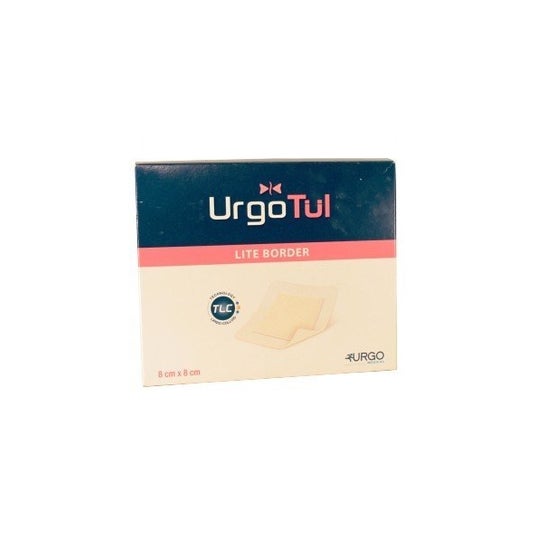Absorbent interface dressing consisting of 3 layers (a TLC-Ag healing matrix; a thin, absorbent compress placed in the centre of the dressing and a white polyurethane backing coated with a high skin tolerance adhesive mass) ideal for local wound treatment.
Urgo Urgotul Lite Border 10X12Cm 16
30,28€ by redeeming Health points. Log in
![]() Sent from France
Show details
Sent from France
Show details
Enviado por DocMorris
Dressing for wound care and wound healing
Shipping in 24-72h
30,28€ by redeeming Health points. Log in
![]() Sent from France
Show details
Sent from France
Show details
Enviado por DocMorris
Description
Instructions for use
Clean the wound with saline solution. Then, remove the protective flaps of the product and apply directly on the wound by placing the side of the weft on the side of the wound. It should be renewed between 1 and 3 days depending on the wound to be treated. The treatment has a maximum duration of 1 month.
Composition
TLC-Ag healing matrix impregnated with silver salts
Unit price
Pharmaceutical Advice
Plasters, adhesive bandages or dressings are patches that have a sterile gauze pad in the centre, surrounded by an area that sticks to the skin. They are used to protect open wounds, prevent infection and facilitate the healing process.
There are different types of plasters depending on the type of injury. To choose the right dressing, you need to consider the conditions the wound will be subjected to. They come in multiple sizes, materials, colours, flexibility, and can even be water-resistant. They may also have an additional ingredient with antiseptic properties to ensure a better healing process.
It is essential to clean the wound with water and soap, disinfect it and carefully dry the area with a sterile gauze before applying a dressing to any type of wound. Afterwards, simply remove the protective elements and make sure that the gauze pad, not the adhesive part, completely covers the wound.
Remember that the dressing is intended to protect the skin until it forms a protective scab. Unless the wound is in a rubbing area, it is preferable to remove the plaster once the scab has formed so that it can heal completely.
Please note that plasters are only indicated for blistering or minor bleeding. If the wound is very large or deep, you should consult your doctor, who will be able to assess how you should to proceed.
Safety and product information
Safety visual aids
At this time we do not have safety images for this product, but we are working on it. We encourage you to check back later for updates. In the meantime, we recommend that you read the safety information that comes with the product before using it. If you have any questions about safety, please do not hesitate to contact us. Also, if you wish, you can also return the product by following our terms and conditions.
Manufacturer details
Manufacturing data details relevant information from the product manufacturer.
Urgo Healthcare
Barrio de la Florida, 29 20120 Hernani- Guipúzcoa
info@es.urgo.com
https://urgo.es/
RELATED SEARCHES ABOUT Bandages
New in Flesh wounds
- Nexcare N1530-1D Papel Adhesivo 25mmx5m 1ud
- Leukoplast Leukomed Skin Sensitive 8x10cm 5uds
- Alvita Agua Purificada 1L
- Euroreel Adhesivo Algodón 5mx1.25cm
- Hansaplast Second Skin Protection XL 3 apósitos
- Hansaplast Second Skin Protection Regular 6 apósitos
- Holbasic Alcohol Etilico Sanitario 70° 250ml
- Bastos Viegas Vendaje Gaza 10x10 10uds
- Master Aid Duolastic Vendaje Elastico7mx10cm
- Bastos Viegas Compresa 427/021 10x10 100uds


